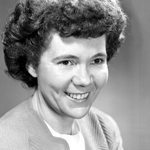Jane Hamilton Hall
Jane Hamilton Hall | |
|---|---|
Los Alamos Laboratory | |
| Thesis | The temperature diffuse scattering of X-rays by potassium chloride and potassium bromide crystals (1942) |
Jane Hamilton Hall (23 June 1915–November 1981) was an American physicist. During World War II she worked on the Manhattan Project. After the war she remained at the Los Alamos National Laboratory, where she oversaw the construction and start up of the Clementine nuclear reactor. She became assistant director of the laboratory in 1958. She was secretary of the General Advisory Committee of the Atomic Energy Commission from 1956 until 1959, and was a member of the committee from 1966 to 1972.
Biography
Jane Hamilton was born in Denver, Colorado, on 23 June 1915.[1] She entered the University of Chicago, where she earned her Bachelor of Science (B.S.) degree in 1937, her Master of Science (M.S.) in 1938, and her doctorate (Ph.D.) in physics in 1942,[2] writing her thesis on "the temperature diffuse scattering of X-rays by potassium chloride and potassium bromide crystals".[3] There, she met and married David Hall, a fellow physics student,[2] in 1939.[1] They had two children, Malcolm and Linda.[4] She was a member of Alpha Gamma Delta, an international women's fraternity.[5]
After working for a year as instructors at the
Hall was seconded to DuPont, where she became a senior supervisor at the Hanford Engineer Works.[6] Hall and David moved there in mid-1944, and supervised the construction of the B Reactor there, followed by the D and F Reactors.[7] In October 1945, Enrico Fermi brought Hall to the Argonne National Laboratory as an associate physicist and assistant to himself as the laboratory director.[8]

But in November 1945, Hall and David accepted positions at the
Hall's research interests included nuclear reactor development,
Hall became associate director of the Los Alamos National Laboratory in 1958. That year she was an American delegate at the
Notes
- ^ ISSN 0192-8570. Howes & Herzenberg give her birth year as 1923; this is an error.
- ^ a b c Howes & Herzenberg 1999, pp. 43–45.
- . Retrieved 12 July 2016.
- ^ a b "Scientists Not Political Sages Says U.S. Woman Physicist". Schenectady Gazette. 13 November 1970. Retrieved 12 July 2016.
- ^ "Alpha Gamma Delta Quarterly". Winter 2018.
- ^ a b c d e f "Jane Hall to Receive AEC Citation" (PDF). The Atom. 7 (7). July–August 1970. Retrieved 12 July 2016.
- ^ a b c d "David Hall's Interview". Manhattan Project Voices. Retrieved 12 July 2016.
- ^ a b Howes & Herzenberg 1999, pp. 194–195.
- ^ a b Bunker, Merle E. (Winter–Spring 1983). "Early Reactors From Fermi's Water Boiler to Novel Power Prototypes" (PDF). Los Alamos Science: 124–131. Retrieved 12 July 2016.
- ^ Rhodes 1995, p. 474.
- ^ Sylves 1987, p. 65.
- ^ "United States Social Security Death Index," database". Family Search. 19 May 2014. Retrieved 25 July 2016.
References
- OCLC 49569088.
- OCLC 32509950.
- Sylves, Richard Terry (1987). The Nuclear Oracles: a Political History of the General Advisory Committee of the Atomic Energy Commission, 1947–1977. Ames: Iowa State University Press. OCLC 15630365.
